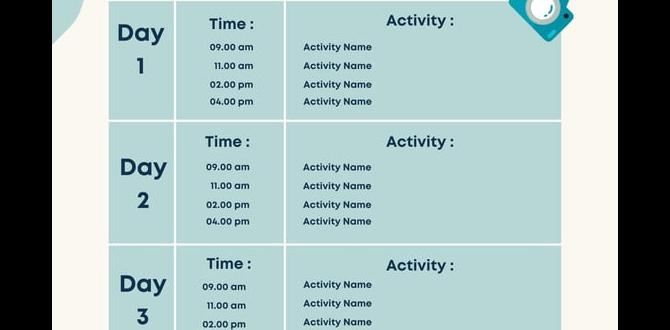Discover the best Basque Country walkable routes with essential maps to guide your journey, ensuring a delightful and stress-free exploration of this beautiful region.
The Basque Country is a hiker’s paradise, offering stunning coastal paths, rolling green hills, and charming villages. But planning your walks can feel a little overwhelming, especially if you’re new to the area. You might wonder where to start, which trails are best for beginners, and how to navigate without getting lost. Don’t worry, we’ve all been there! This guide is here to help. We’ll break down some fantastic walkable routes and show you exactly how to find the essential maps you need for a confident and enjoyable adventure. Get ready to explore the heart of Basque Country on foot!
Navigating Basque Country on Foot: Your Essential Map Guide
Exploring the Basque Country means embracing its diverse landscapes, from sandy beaches to dramatic cliffs and verdant inland valleys. Walking here offers an intimate connection with the culture, history, and natural beauty that defines this unique corner of Spain and France. For many travelers, especially those who appreciate a slower pace or want to truly soak in the surroundings, walking is the ultimate way to experience the region. But the beauty of a walking holiday lies in preparation. Knowing where to find reliable maps and understanding the types of routes available can make all the difference between a dream trip and a frustrating one.
Whether you’re aiming for a leisurely stroll along the coast, a challenging trek in the Pyrenees, or scenic routes connecting picturesque villages, having the right navigational tools is key. This guide is designed to equip you with the knowledge to find and use essential maps for Basque Country walkable routes, ensuring your adventures are both safe and memorable. We’ll cover everything from digital resources to traditional paper maps, and highlight some of the most beloved walking trails.
Why Walking is the Perfect Way to See the Basque Country
The Basque Country brims with character. Its culture is rich, its food is legendary, and its landscapes are breathtakingly varied. Walking allows you to:
Experience the Scenery Up Close: Feel the sea spray on the coastal paths, smell the wildflowers in the meadows, and hear the quiet rustle of leaves in the forests.
Discover Hidden Gems: Wander off the beaten path to find secluded coves, tiny hermitages, and local taverns not accessible by car.
Connect with Locals: Chance encounters with farmers, shepherds, and villagers offer genuine insights into Basque life.
Enjoy Health and Wellbeing: Hiking is fantastic exercise, and the tranquil settings promote mental well-being and stress relief.
Travel Sustainably: Walking is one of the most environmentally friendly ways to explore, leaving a minimal footprint.
For families, it’s a chance to create shared memories. For solo travelers, it’s an opportunity for introspection and discovery. Even for those who typically rely on other forms of travel, the ease of access to many well-maintained paths makes walking an appealing option. And for anyone who needs to manage personal care needs, like carrying adult or child diapers for extended trips, the predictability of walking routes can offer a sense of comfort and control, allowing for planned stops and breaks.
Understanding Basque Country Walking Trails
Basque Country offers a spectrum of walking experiences, catering to all fitness levels and interests. The trails are generally well-marked, especially those that are part of longer, established routes.
Types of Trails You’ll Encounter:
Coastal Paths (Sendas Litorales): Hugging the Bay of Biscay, these trails offer dramatic cliff views, charming fishing villages, and access to beautiful beaches. They can range from easy, paved promenades to rugged, uneven terrain. The Senda Litoral de Gipuzkoa is a prime example, with sections suitable for all.
Inland Hikes (Senderismo Interior): Explore rolling hills, ancient forests, and the foothills of the Pyrenees. These routes often lead to historical sites, traditional farmhouses (caseríos), and offer stunning pastoral scenery.
Long-Distance Trails: The Basque Country is crisscrossed by significant long-distance paths, including parts of the Camino de Santiago and the Euskal Herria network. These are often well-signposted and serviced with albergues (hostels) for multi-day trekking.
Circular Routes (Rutas Circulares): Ideal for day-trippers, these trails start and end at the same point, making navigation simpler.
Difficulty Ratings:
Most well-established walking routes will have a difficulty rating. In general, you can expect:
Easy (Fácil/Fácil): Relatively flat terrain, well-maintained paths, suitable for all ages and fitness levels.
Moderate (Moderado/Modere): Some inclines, uneven surfaces, requires a reasonable level of fitness.
Difficult (Difícil/Difficile): Steep ascents/descents, rocky or challenging terrain, requires good physical condition and experience.
Essential Tools for Your Basque Walks: Maps and Navigation
The cornerstone of any successful walking trip is reliable navigation. While the Basque Country boasts increasingly good signage, a map is your insurance policy against getting turned around and ensures you can confidently explore.
1. Digital Mapping Apps and Websites
In today’s world, your smartphone can be a powerful navigation tool. Several apps and websites offer detailed topographic maps, route planning, and offline capabilities, which are crucial in areas with limited mobile signal.
AllTrails: A popular app with a vast database of trails worldwide, including many in the Basque Country. Users can download maps for offline use, read reviews, and share their experiences.
Komoot: Excellent for route planning and navigation. It’s particularly good for different types of activities, including walking and hiking. It allows you to download region packs for offline use.
Wikiloc: Hugely popular in Spain, Wikiloc hosts a massive collection of GPS tracks uploaded by users. You can find routes for almost anywhere, and many are highly detailed. Offline maps are a premium feature.
Spain’s National Geographic Institute (IGN): The official mapping agency for Spain. Their website (www.ign.es) offers a digital map viewer and the ability to download topographic maps in various formats. This is a fantastic resource for detailed, official information.
OpenStreetMap (OSM): An open-source mapping project. Apps like OsmAnd use OSM data and allow for extensive offline map downloads. Many hiking-specific apps also use OSM as their base layer.
Tips for Using Digital Maps:
Download Maps Offline: Always download the maps for your intended route before you leave your accommodation or a Wi-Fi hotspot.
Carry a Portable Charger: Batteries can drain quickly when using GPS. A power bank is an essential accessory.
Learn the App: Familiarize yourself with your chosen app’s features before your trip.
Backup: Don’t rely solely on your phone. Consider a waterproof case and a physical map as a backup.
2. Traditional Paper Maps
Despite the convenience of digital tools, there’s a timeless reliability to paper maps that many seasoned hikers still prefer, especially for longer treks or in areas where electronic devices might fail.
IGN (Instituto Geográfico Nacional) Maps: These are the most authoritative topographic maps of Spain. They come in various scales, with 1:25,000 being ideal for detailed hiking. You can purchase these online or at local bookstores and outdoor shops in Spain. Look for the Serie MTN25 (Topographic Map Series 1:25,000).
Local Tourist Offices: Many tourist information centers in Basque towns and cities will have free or purchasable maps of local walking routes and the wider region.
Specialized Outdoor Retailers: Shops catering to hikers and mountaineers will stock a good selection of maps, guidebooks, and walking-specific atlases.
Pros and Cons of Paper Maps:
Pros: No batteries required, easy to see the bigger picture at a glance, durable if kept dry, satisfying to use.
Cons: Can be bulky, susceptible to damage from water/wear, requires learning to read topographic lines and symbols, may not be as up-to-date as digital versions.
3. Walking Guidebooks
For a more structured approach, consider a good walking guidebook for the Basque Country. These books often include detailed route descriptions, historical and cultural notes, difficulty ratings, and importantly, the maps for each specific walk. They provide context and a curated selection of the best routes.
Key Basque Country Walkable Routes & Essential Maps for Beginners
Here are a few beginner-friendly route ideas in the Basque Country, along with how to find maps for them.
Route 1: The Coastal Path near San Sebastián (Donostia)
This is a classic for a reason. A relatively easy and incredibly scenic walk.
Route: The walk from La Concha Beach to Monte Urgull, and then continuing along the coast towards Monte Igueldo offers stunning views of the bay, the city, and the Gaviota Lighthouse. You can choose to do short sections or the full loop.
Why it’s great for beginners: Paved paths, well-maintained, easy to follow, and you can bail out and return to the city easily at any point. The ascents up Urgull and Igueldo are manageable.
Maps:
Digital: Search for “Monte Urgull walk” or “San Sebastian coastal walk” on AllTrails, Komoot, or Wikiloc. You’ll find many user-uploaded GPX tracks and descriptions.
Paper: Local tourist offices in San Sebastián will have excellent city maps that highlight pedestrian routes and points of interest, including the paths on Urgull. IGN maps (MTN25 series) covering the San Sebastián area (e.g., sheet 79-IV) will show the terrain and paths in detail.
Route 2: The Green Way of the Urola Valley (Gipuzkoa)
A beautifully converted old railway line, this “Via Verde” is perfect for a gentle, traffic-free walk or cycle.
Route: The Vía Verde del Urola stretches for about 16 kilometers between Lasarte-Oria and Legazpi, passing through charming towns like Azpeitia (home to the Basque Railway Museum) and Zumarraga. You can walk any section of it.
Why it’s great for beginners: Almost entirely flat, paved or well-compacted gravel surface, car-free, and you can easily access it from multiple points.
Maps:
Digital: Type “Vía Verde Urola” into Wikiloc or Komoot. You’ll likely find GPX tracks and descriptions. Dedicated “Vías Verdes” websites often have downloadable route maps, such as the official Spanish government portal for greenways.
Paper: Tourist offices in towns along the route (e.g., Azpeitia, Zumarraga) will often have brochures or maps of the Vía Verde. IGN maps covering the region will show the path of the old railway line.
Route 3: The Basque Coast Geopark Walks (Gipuzkoa)
Along the stunning coastline between Zumaia and Deba lie dramatic flysch formations and spectacular viewpoints.
Route: The Geopark offers several marked trails. A popular section is the path connecting Zumaia to Santiago beach, or the longer coastal path that eventually leads towards Deba. These routes involve some ups and downs, but the scenery is unparalleled.
Why it’s great for beginners (with a little caution): While some sections are well-maintained, others can be uneven or have steep climbs. However, shorter segments and paying close attention to signage make it manageable. The views are well worth the effort.
Maps:
Digital: The official Basque Coast Geopark website (geoparkea.com) is an excellent resource. They often provide downloadable PDF maps of their recommended routes. Search “Basque Coast Geopark trails” on Komoot or AllTrails.
Paper: Look for maps at the Geopark’s interpretation centers (e.g., in Zumaia) or local tourist offices. IGN maps of the coastal area (e.g., sheets 90-1, 90-2, 116-3) will show the coastline and paths.
Route 4: Mount Artxanda (Bilbao)
For incredible panoramic views of Bilbao without leaving the city limits.
Route: Accessible via a funicular or walking paths, Mount Artxanda offers several short, easy walking circuits at the top, with viewpoints overlooking the entire city and Nervión river estuary.
Why it’s great for beginners: Very accessible, well-maintained paths, and you can take the funicular up and walk down, or vice versa. Short circuits at the summit are easy strolls.
Maps:
Digital: Search for “Mount Artxanda walk” or “Parque Etxebarria” (another great viewpoint park) on mapping apps.
Paper: Bilbao’s tourist information centers will have maps of the city, often highlighting green spaces and viewpoints like Artxanda.
Planning Your Walk: What to Pack and Bring
Beyond maps, being prepared with the right gear ensures comfort and safety. This is where practical essentials come into play.
Footwear: Comfortable, broken-in walking shoes or hiking boots are a must.
Clothing: Layers are key. Even in summer, coastal breezes can be cool. Bring a waterproof and windproof jacket.
Water and Snacks: Always carry more water than you think you’ll need. Local produce like Basque cherries or Idiazabal cheese make for fantastic trail snacks.
Sun Protection: Hat, sunglasses, and sunscreen, especially for coastal walks.
First-Aid Kit: Basic supplies for blisters, cuts, or stings.
Mobile Phone: Fully charged, and a portable power bank.
Whistle: For emergencies.
Personal Care Items: Don’t forget any essential personal items, such as medication or practical aids like adult or child diapers if needed. Knowing you have these essentials packed can alleviate a lot of travel stress, allowing you to focus on enjoying the walk. Many products are designed for discretion and comfort during physical activity and long travel days.
Navigating Etiquette and Safety on the Trails
Stay on Marked Paths: Avoid wandering off-trail, especially in sensitive natural areas.
Respect Nature: Take all litter with you, and avoid disturbing wildlife.
Right of Way: Hikers generally have right of way, but be considerate of cyclists on greenways and faster walkers.
Check the Weather: Conditions can change rapidly, especially in mountainous or coastal areas.
Inform Someone: Let your accommodation or a friend know your planned route and expected return time.
Emergency Numbers: In Spain, the emergency number is 112.
The Camino de Santiago: A Famous Basque Walking Route
While not just a “Basque Country” route, a significant portion of the Camino Francés passes through the Basque Country. If you’re considering a multi-day trek, this is an iconic choice.
Key Basque Sections: The route enters the Basque Country from the east, passing through towns like Roncesvalles (Navarra, bordering Basque Country), Zubiri, and stretching towards the coastal city of Irún or inland towards Pamplona.
Why it’s popular: Steeped in history, incredibly well-marked, excellent infrastructure of albergues, and a profound sense of community among pilgrims.
Maps & Resources:
Official Websites: The Spanish government tourism portal and various regional Camino sites offer route descriptions and sometimes downloadable maps.
Guidebooks: Numerous dedicated Camino de Santiago guidebooks are available, often including detailed maps for each stage. Look for those specifying the Basque sections.
App Recommendations: Wise Pilgrim, CaminoTool, and Gronze are popular Camino-specific apps that offer maps, albergue listings, and GPS tracking.
* IGN Maps: For those who want detailed topographic maps, use the IGN 1:25,000 or 1:50,000 series covering Navarra and Gipuzkoa. The Camino de Santiago is usually clearly indicated.
Here’s a look at what you might find when researching specific routes:
| Route Name | Location | Approx. Length | Difficulty for Beginners | Type of Terrain | Key Features | Essential Map Type |
|---|---|---|---|---|---|---|
| Monte Urgull Circuit | San Sebastián | 2-5 km | Easy | Paved paths, some steps | City views, castle ruins | Local tourist map, digital app |
| Vía Verde del Urola (section) | Gipuzkoa | 5-15 km (one way) | Very Easy | Flat, paved/gravel | Former railway, river views, museums | Greenway websites, digital app |
| Zumaia to Santiago Beach | Basque Coast Geopark | 4-6 km (one way) | Moderate | Coastal path, some ascents/descents | Flysch formations, sea views | Geopark website, IGN map |
| Mount Artxanda Loop | Bilbao | 1-3 km | Easy | Paved paths, some inclines | Panoramic city views | Local tourist map, digital app |
This table gives a quick snapshot. Remember to always check the specifics of the route you choose based on the maps and descriptions you find!




